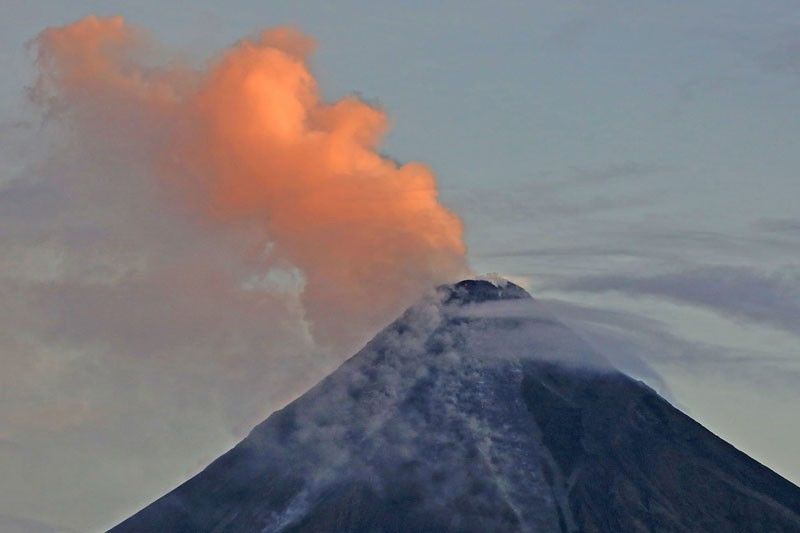Mayon’s lava fronts may breach ‘no man’s land’

LEGAZPI CITY , Philippines — A sustained oozing out of fresh and fiery volcanic materials from the summit crater of Mayon Volcano continued on its seventh day yesterday, increasing the possibility that lava fronts would breach the six-kilometer permanent danger zone (PDZ) dubbed as “no man’s land.”
Amid these developments, the Philippine Institute of Volcanology and Seismology (Phivolcs) was also monitoring activity at Taal Volcano in Batangas, about 300 km west-northwest of Mayon, which as of Sunday had recorded 46 volcanic tremors and 7,643 tons of sulfur dioxide emissions per day.
In Mayon, Phivolcs reported detecting in the past 24 hours the very slow effusion of lava from the summit crater, feeding lava flows and collapsed debris along the Mi-isi (south) Gully in Daraga town and the Bonga (southeastern) Gully in this city in Albay.
“If this slow but unabated lava flow would continue, lava fronts could travel beyond the six-kilometer permanent danger zone. Though today, it is still at the upper crater,” Paul Alanis, resident volcanologist at Lignon Hill Observatory where Mayon’s lava extrusion could be seen in full view, told The STAR.
In the past 48 hours, Phivolcs said that lava flows already stretched to 1,500 meters, while collapsed debris had settled at 3,300 meters from the summit.
Collapsed super-heated pyroclastic density currents (PDCs) had been recorded at least 33 times in the past 72 hours, Phivolcs data showed.
“As some of the abnormal measures are slightly increasing, while other restive signs are slightly decreasing, we can say that the overall condition of Mayon remains at Alert Level 3 para-meters,” Alanis said.
He said that the rockfall events and PDCs slightly decreased, but the sulfur dioxide emissions and volcanic earthquakes slightly increased in the past 24 hours compared to the previous day’s recording.
Phivolcs said there were also 11 dome-collapse PDCs that lasted two to six minutes, 274 rockfall events, and three volcanic earthquakes in the Saturday-to-Sunday monitoring period.
Taal Volcano also restive
Meanwhile, Alert Level 1 remains in Taal Volcano, where the Phivolcs has recorded at least 46 volcanic tremors and a weak emission of plumes reaching 600 meters tall and drifting northwest yesterday.
State volcanologists observed shorter-term inflation of the western Taal Volcano island and long-deflation of the Taal caldera.
Phivolcs has disallowed entry into Taal Volcano island, especially the main crater and Daang Kastila fissures; occupancy; boating on Taal Lake, and flying any aircraft close to the volcano.
It warned steam-driven or phreatic or gas-driven explosions, volcanic earthquakes, minor ashfall, and lethal accumulations or expulsions of volcanic gas can occur at any time.
The Phivolcs has been closely monitoring Taal Volcano since it showed increased activity last June 10, two days after Alert Level 3 was raised in Mayon Volcano.
Mayon evacuees rise to 19,796
Eugene Escobar, officer-in-charge of the Albay Public Safety and Emergency Management Office, said that as of 8 a.m. yesterday, Mayon evacuees further rose to 5,741 families or 19,796 persons.
Evacuations started when Phivolcs declared Alert Level 3 on June 8. The affected families are now staying at 25 evacuation centers in Albay’s two cities and six towns surrounding Mt. Mayon. Alanis noted that during the last major eruption of Mayon Volcano in 2018, the volcano released hot rocks and lava.
“We did not reach a Pinatubo-style (eruption) of Mayon Volcano. That’s already an extreme case,” he said, but added that the current high level of activity in Mayon is likely to persist for three months more.
“Based on the history of the volcano, its restiveness can last for weeks or even until three months. During its eruption in 2018, it persisted for 90 days,” Alanis said.
At the same time, Alanis backed moves to declare the 6-km PDZ radius of Mayon Volcano as a national park and disallow human habitat. “It can help if permanent habitation is prohibited (in the PDZ),” he said.
For now, Phivolcs announced: “Increased vigilance against pyroclastic density currents, lahars and sediment-laden streamflows along channels draining the edifice is also advised. Heavy rainfall could generate channel-confined lahars and sediment-laden streamflows in channels where pyroclastic density deposits were emplaced.”
It added that civil aviation authorities must also advise pilots to avoid flying close to the volcano’s summit as ash from any sudden eruption can be hazardous to aircraft.
Based on the current prevailing wind pattern, ash fall events may most likely occur on the south side of the volcano.
DepEd: Don’t suspend classes
The Department of Education (DepEd) in Bicol has ordered concerned officials and teachers not to suspend the holding of classes even as their schools are being used as evacuation centers for families displaced by the high level of unrest of Mayon Volcano.
Mayflor Jumamil, DepEd-Bicol spokesperson, said more than 24,500 elementary and high school students have been displaced in 35 public schools utilized as evacuation sites.
“Our DepEd-Bicol director, Gilbert Sadsad, ordered heads and teachers of the affected schools to implement contingency measures in order to continue holding of classes until the last school day on July 9,” Jumamil told The STAR.
Based on their monitoring, Jumamil said that the school officials and the concerned teachers immediately responded to the “no class suspension” order by shifting to modular, alternate face-to-face and online, or holding classes outside regular classrooms.
Jobs for evacuees
In another development, the Department of Labor and Employment (DOLE) announced an emergency employment program for displaced residents near Mayon and that it has already started the profiling process to employ thousands.
“One member from each affected family will be paid P10,950 for doing community gardening near the evacuation centers, temporary shelter maintenance and housekeeping as well as food preparation,” a DOLE statement read.
Earlier, the DOLE turned over P50 million to local government units affected by Mt. Mayon’s effusive eruption for the implementation of the Tulong Panghanapbuhay sa Ating Disadvan-taged/Displaced Workers or TUPAD program.
The DOLE has also pledged to provide livelihood assistance to the evacuees even after they eventually return to their homes. — Bella Cariaso, Mayen Jaymalin
- Latest
- Trending


























